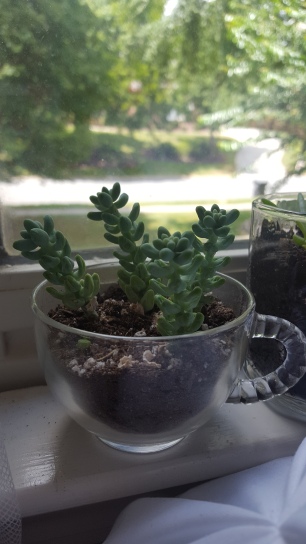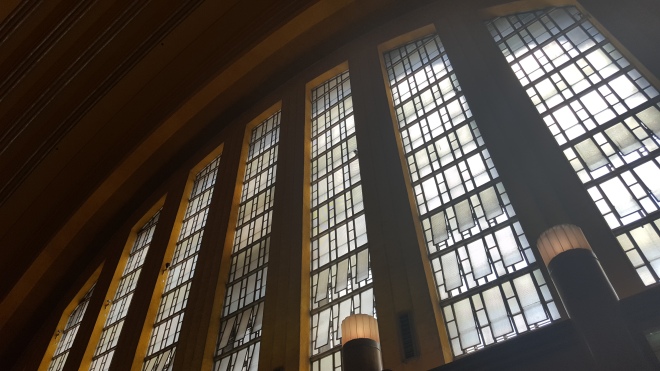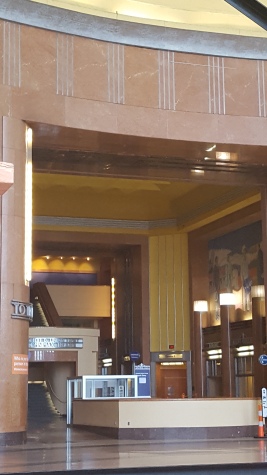Church yard sales are good for many things. For example, you might find a nice hand mixer for $5 or a crock pot which has likely cooked for many potluck dinners for $10. You might walk around and see an old record player that could be pretty cool if you had any idea how to fix an old record player. You might see 5 or 6 enormous tube televisions which weigh 200 pounds each and which no one is interested in because, come on, it’s 2017.
And then you might come back later in the day, just before closing, to see what’s left. And when you do, you might stumble upon a China cabinet which is just the right size and has those lovely tapered spindle legs which you love so much. And it’s practically perfect. So you ask how much and you walk away with a $10 vintage treasure.

And it needs a little work. Someone clearly had it near a window, it’s all faded in places. It probably had a house plant sitting on top that someone drowned. You can tell because of the rings of water damage. But, you say to yourself, it was only $10 and I’m going to fix it. And when you open it, it’s full of spiders. So you recoil and decide that it’s really gross how many spiders are living in this thing. Ugh!!! Is that an egg sack?!? It is.
You aren’t even quite sure what color the wood is supposed to be because it’s so faded, but it needs to be stained anyway. So you settle on a nice dark brown to compliment some of your other furniture. Yeah, that sounds nice. Lucky for you they sell Polyshades that can be applied over previously finished surfaces with only a little sanding. Because sanding sucks and you don’t want to do more than you have to.
Before you can do all of that though, you take the doors off. And because you are very unlucky, the screws are stripped. And one of the hinges is super bent which makes it basically impossible to get off. So you call in your reinforcements (your dad) and he helps you get it off. You also take off those rad brass drawer pulls. And you also take out the creepy green felt drawer liner because it’s covered in guess what? More spiders.
You decide, then, that it is time to go to the hardware store to get some of the previously mentioned Polyshades as well as some brushes and new hinges for the doors because the super bent hinge is not great. But because you are unlucky, and because it is 2017, they don’t make the weird hinges that you need. They are a strange size. They have a strange number of holes. They are probably from 1955 and therefore aren’t produced anymore. You get frustrated and purchase the rest of your materials and then go to another hardware store down the road. And another. And you’re pretty much over this. Face it, they don’t make these anymore. So your reinforcements (your dad) come to your rescue and hammer it until it’s flat again. See? Good as new.

Now you can begin the sanding. And maybe since you hate it so much (it gets in your contact lenses!), your mom helps you. And you sit on the floor with the doors and sand them by hand with a 60 grit block. The weird faded stain dust gets all over your legs. And your hands. And your t-shirt. Once you use a tack cloth to wipe away all the dust that has now gotten all over your life, it’s time to stain.
You use a natural bristle brush like the can says. You apply a thin layer like the can says. You wait 6 hours for the first coat to dry like the can says. You come back and poke a little section afterwards to see if it’s ready. It feels sticky and gross. It leaves fingerprints behind. It’s just humid you tell yourself. It’s always humid. It’s the South in the summertime. So you think maybe it needs a little extra time like the can says. You check on it later. It’s still tacky. You check multiple times each day. You set up a box fan which blows on it for 12 hours a day. Five days later, it is finally dry. It is time to use the steel wool like the can says. You don’t use 000 grade steel wool like the can says. You don’t have any so you settle for 00 instead. It works fine anyway. After you put 2 more coats on (which dry in the appropriate amount of time) you notice that the doors have little bits of debris that have dried into the stain. Well, crap you think to yourself. They look really bad. Because you’re unlucky and that’s how these things go. Is that cat hair? It is. The friendly neighborhood cat has been hanging around while you paint. It’s a wonder he didn’t get wet polyurethane on his fur.
Your mom sands again because you hate sanding. While she does, you scrape excess stain off the sides where it dripped. You also clean off the mysterious sticky goo that has accumulated on the side of your precious cabinet. You go to check up on the doors and then you see that the stain, which wasn’t going on super evenly to begin with, has not come off evenly either. It would be very hard to redo because it would still be uneven and gross. You despair.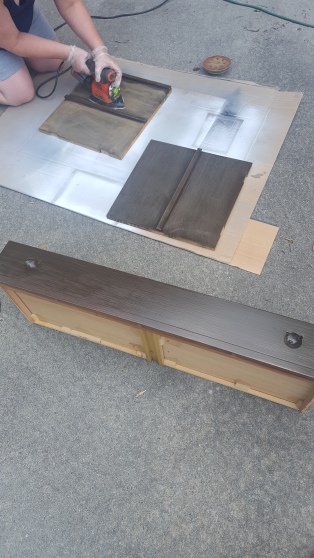
Once your despair passes, you turn to your most trusted ally (Pinterest).You look for some ways to fix the mess you’ve created and you find some pictures of a TV console that has a wood exterior and white doors and drawers. Ah, yes! you think. A solution! You have a can of white furniture paint from when you made your kitchen table and it will cover the splotchy patches on the doors. And you will have to paint the drawer too to be consistent. You will have to sand it. Actually, your mom will have to sand it because you hate sanding. Once it’s sanded though, you decide you can fix it.
But there is a dilemma. Because you are unlucky. And that dilemma is: should you stain the raised details on the doors to keep the outline aesthetic you’re going for or should you paint it white like the rest of the door (which would be a lot easier)? You ask yourself Am I willing to suffer for the Aesthetic? And the answer is probably yes. But you are unlucky, so we’ll see how it goes.
If this story sounds familiar, then you are probably me, trying to wrestle a mid-century cabinet. And if you aren’t me, then we are joined in suffering as we try to wrestle our furniture into something a little more stylish and a little less sun bleached.
Stay tuned for Part 2 where we find out what happened with the paint job!






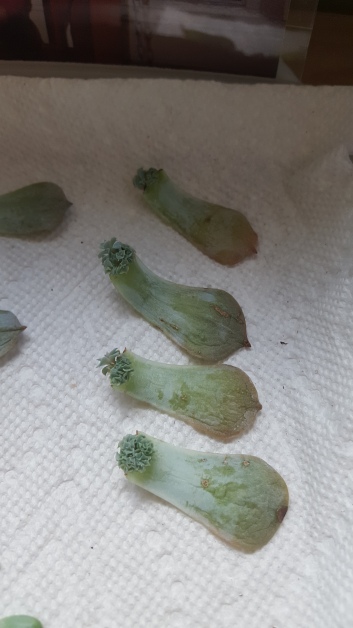 The sprouts took a few weeks to appear, but now that they’ve started to grow, there’s no slowing them down! I’ve started planting them in tea cups as cute gifts for friends. They also make perfect decorations for window sills and shelves that need a little life.
The sprouts took a few weeks to appear, but now that they’ve started to grow, there’s no slowing them down! I’ve started planting them in tea cups as cute gifts for friends. They also make perfect decorations for window sills and shelves that need a little life.